September 16, 2014
Country Well-Being Varies Greatly Worldwide
Panamanians have the highest well-being globally; Syrians and Afghans, the lowest
This article is the first in a series of three articles exploring worldwide perceptions of well-being in the five well-being elements of the Gallup-Healthways Global Well-Being Index: purpose, social, financial, community, and physical.
WASHINGTON, D.C. -- One in six adults worldwide are considered thriving -- or strong and consistent -- in at least three of the five elements of well-being, as measured by the inaugural Gallup-Healthways Global Well-Being Index in 2013. Residents of the Americas region are the most likely to be thriving in three or more elements (33%), while those in sub-Saharan Africa are the least likely (9%).
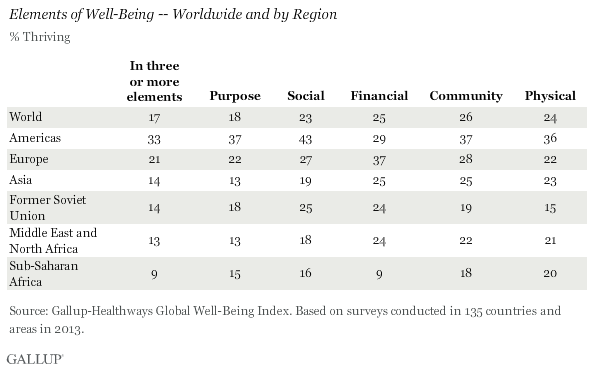
Each element of well-being is important on its own, but the elements are also interdependent and well-being is more than the sum of the elements. That only 17% of residents in the 135 countries and areas surveyed are thriving in three or more elements underscores how most of the world is struggling to achieve high well-being.
More adults globally are thriving in community well-being (26%) than in any other element. Residents in the Americas region, with more than one in three (37%) thriving, are most likely to be thriving in this element. Adults in sub-Saharan Africa are the least likely to be thriving (18%).
Fewer adults globally are thriving in purpose well-being than in any other element. Adults in Asia, as well as the Middle East and North Africa, are least likely to be thriving in this element (13% in each region), while those in the Americas again top the list of regions, at 37% thriving in purpose well-being.
Global Well-Being Index Largest Recent Global Study of Well-Being
The Global Well-Being Index is an extension of more than six years of research and 2 million interviews in the U.S. through the Gallup-Healthways Well-Being Index. The Global Well-Being Index is a global barometer of individuals' perceptions of their well-being and is the largest recent study of its kind. Data collected in 2013, across 135 countries and areas, and with more than 133,000 interviews, have been compiled into the State of Global Well-Being, a comprehensive report presenting the global demographics of well-being. The Global Well-Being Index is organized into the five elements:
- Purpose: liking what you do each day and being motivated to achieve your goals
- Social: having supportive relationships and love in your life
- Financial: managing your economic life to reduce stress and increase security
- Community: liking where you live, feeling safe, and having pride in your community
- Physical: having good health and enough energy to get things done daily
In analyzing the results of the index, Gallup classifies responses as "thriving" (well-being that is strong and consistent), "struggling" (well-being that is moderate or inconsistent), or "suffering" (well-being that is low and inconsistent).
Thriving Rates Highest in Latin American and European Countries
Adults in Latin America are most likely to be thriving in well-being in three or more elements as well as across elements. Latin Americans generally report higher levels of well-being than any other regional group. This is consistent with other Gallup World Poll research that shows residents of Latin America generally evaluating their lives more highly than those in other regional groups, partly reflecting a cultural tendency in the region to focus on the positives in life.

Panama leads not only the region, but the world in four of the five well-being elements -- purpose, social, community, and physical well-being. Sixty-one percent of Panamanians are thriving in three or more elements, 17 percentage points ahead of its second-place neighbor, Costa Rica (44%). Panama's strong and growing economy, an unemployment rate of 4.5% in 2013, and national development may be the most significant factors contributing to its high thriving levels.
Financial well-being is the only element in which other countries' residents top Panama's. Swedes lead the world in financial well-being, with 72% thriving. Financial well-being is high across a range of northern and central European countries, including Austria (64% thriving), Denmark (59%), and the Netherlands (56%).
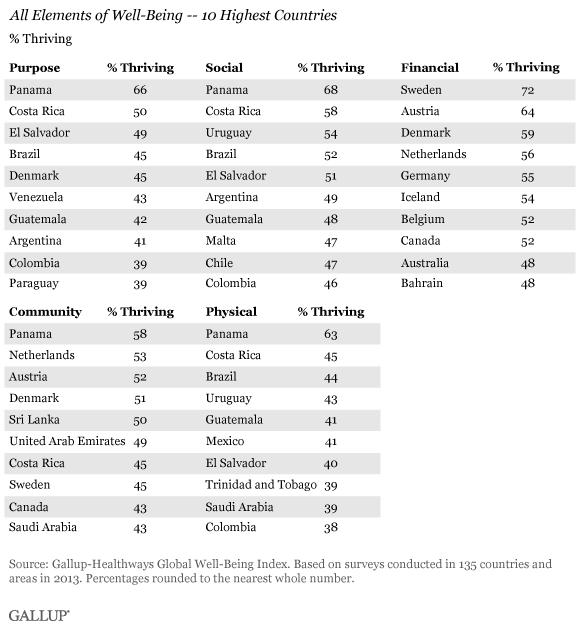
Only five countries outside of the Americas and Europe regions have levels of thriving within an element that rank in the top 10 of all countries -- Bahrain in financial well-being (48%), Saudi Arabia in community well-being (43%) and physical well-being (39%), Malta in social well-being (47%), and Sri Lanka (50%) and the United Arab Emirates (49%) in community well-being. No countries outside of these two regions finished in the top 10 in thriving in three or more elements.
Sub-Saharan Africa Least Thriving Region
Adults in sub-Saharan Africa are the least likely to be thriving in three or more elements of well-being (9%), in addition to their low levels of financial well-being (9%), social well-being (16%), community well-being (18%), and physical well-being (20%). Democratic Republic of the Congo (DRC), Chad, Madagascar, Uganda, and Benin residents have some of the lowest levels of thriving in the world. Most of these countries are plagued by war, political turmoil, low levels of development, and endemic corruption. DRC, for example, has been embroiled in nearly continuous conflict since 1996, and is rife with political instability.
Although subjective well-being is dire in many sub-Saharan African countries, the situation is worse in Afghanistan and Syria. In 2013, just 1% of Syrian and Afghan adults were thriving in three or more elements; the two nations share the lowest well-being of the 135 countries and areas in the 2013 survey. Both countries are conflict zones. By the end of 2013, the United Nations High Commissioner for Refugees estimated that 6.5 million of a total population of 22 million Syrians would need humanitarian aid, and 4.25 million of those would be internally displaced.
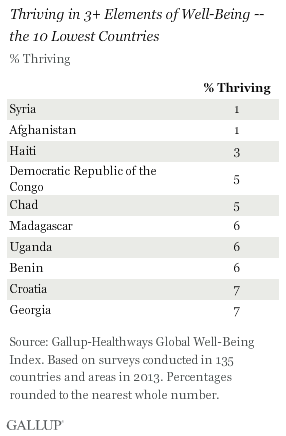
Afghans are also awash in uncertainty about the country's future security situation and its relative stability once foreign aid and investments level off. In a 2013 Gallup World Poll survey, more Afghans said their standard of living was getting worse than in any year since 2008, and most Afghans (61%) said it was a bad time for them to find a job. Against this backdrop, Afghans are the most likely of any population in the world not to be thriving in any element of well-being (75%).
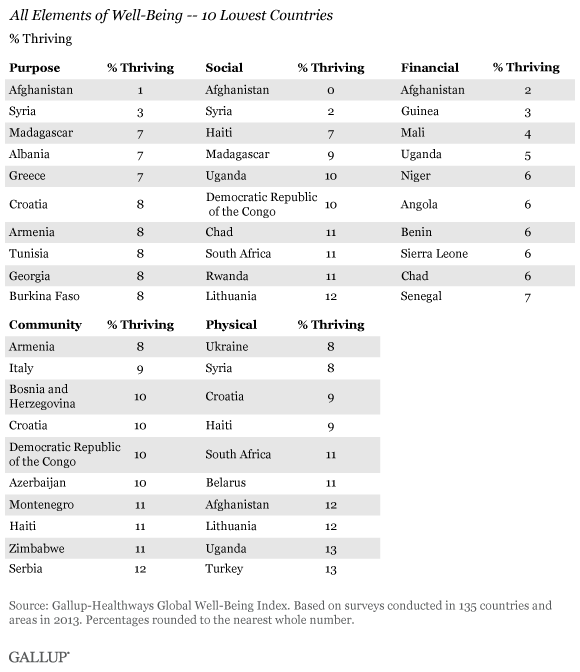
Implications
Objective measures including GDP, life expectancy, and employment statistics are important and useful in assessing a country's "success," as are historical trends over time. However, the concept of subjective well-being encompasses the broader aspects of a life well-lived.
Gallup and Healthways research has shown that people with higher well-being are healthier, more productive, and more resilient in the face of challenges such as unemployment. People with higher well-being bounce back faster, are better able to take care of their own basic needs, and feel better able to contribute to and support the success of their organizations, communities, or countries.
Subjective well-being does not necessarily correlate with GDP, the presence of conflict, or other absolute indicators. Residents in poor countries may report that they have high well-being in certain well-being elements while those in wealthy countries may report that they have low well-being in particular elements. War-torn populations such as those in Syria may have extremely low well-being, but low levels are also found in countries that are relatively stable, such as Croatia and Italy.
There are policy implications for country leadership, development organizations, employers, health insurers (private and governmental), and others in the well-being status of their constituents. For example, Mexico has relatively high physical well-being scores. However, the country overtook the U.S. in 2013 as the most obese country in the Western Hemisphere and grapples with a high rate of diabetes. Diabetes and heart disease are the two most common causes of death in Mexico. While the physical well-being element captures more than just obesity, the high scores on this element in Mexico reveal areas where education is needed to help the population become more aware of health and healthy behaviors, and make better choices.
Because subjective well-being can correlate with outcomes such as healthcare costs, productivity, and business performance, world leaders should consider well-being, in addition to objective measures such as GDP, to provide a better picture of progress toward specific policy and development goals.
Access the full State of Global Well-Being report and 2013 data.
Survey Methods
Results for the Gallup-Healthways Global Well-Being Index are based on telephone and face-to-face interviews on the Gallup World Poll, with a random sample of approximately 133,000 adults, aged 15 and older, living in 135 countries and areas in 2013.
For results based on the total sample of national adults, the margin of sampling error is less than ±1 percentage point at the 95% confidence level. For results based on country-level samples, the margin of error ranges from a low of ±2.1 to a high of ±5.3.
All country-level analyses use country weights. Global and regional analysis uses projection weights that account for country size. Minimum sample sizes of N=300 apply.
In addition to sampling error, question wording and practical difficulties in conducting surveys can introduce error or bias into the findings of public opinion polls.
Each element in the Global Well-Being Index contains two questions asked of all respondents:
Purpose
- You like what you do every day.
- You learn or do something interesting every day.
Social
- Someone in your life always encourages you to be healthy.
- Your friends and family give you positive energy every day.
Financial
- You have enough money to do everything you want to do.
- In the last seven days, you have worried about money.
Community
- The city or area where you live is a perfect place for you.
- In the last 12 months, you have received recognition for helping to improve the city or area where you live.
Physical
- In the last seven days, you have felt active and productive every day.
- Your physical health is near-perfect.
Copyright © 2008-2013 WB5, LLC. All rights reserved.
출처2 http://info.healthways.com/wellbeingindex
미국 갤럽-헬스웨이스 조사..파나마 1위 차지
(댈러스=연합뉴스) 장현구 특파원 = 우리 국민이 느끼는 삶의 질 만족도가 같은 아시아 국가 국민의 체감지수보다도 낮은 것으로 나타났다. 미국 여론조사 기관 갤럽은 보건컨설팅업체 헬스웨이스와 공동으로 지난해 135개국에서 15세 이상 남녀 13만3천 명을 대상으로 전화·면접 조사 방식으로 집계한 2013 세계 웰빙(삶의 질) 지수 순위를 16일(현지시간) 발표했다.
인생 목표, 사회관계, 경제 상황, 공동체의 안전·자부심, 건강 등 5개 항목으로 시행된 여론 조사에서 우리 국민이 3개 항목 이상에서 삶의 질 만족도가 강하고 지속적인 상태를 뜻하는 '번영중'(thriving)이라고 긍정적으로 답한 비율은 14%에 불과했다. 이 순위에서 75위에 머문 한국은 대만(18%·55위), 일본(15%·64위)은 물론 말레이시아(24%·36위), 필리핀(24%·40위), 태국(22%·44위), 인도(15%·71위), 이라크(15%·73위)보다도 밀렸다.
갤럽과 헬스웨이스는 국력, 실질적인 국민 건강상태와 별도로 국민 스스로 느끼는 주관적인 삶의 질 체감 지수를 알아보고자 조사 참가자에게 항목마다 '번영 중', '고전 중'(struggling), '고통받는 중'(suffering) 가운데 하나를 택하도록 했다.
이 결과 우리 국민 대다수는 삶의 목표 실현에서 고전 중(46%) 또는 고통받는 중(40%)이라고 답했다. 응답자의 14%만 목표 실현이 만족스럽다고 답했다.사회관계 또한 고전 중(47%)이라는 답변이 긍정적 답변(22%)의 두 배를 넘었고, 공동체 안전·자부심과 건강 항목에서는 고전 중이라는 응답이 각각 63%, 65%로 과반에 이르렀다. 5개 항목 중 우리 국민이 가장 만족한 부문은 경제 상황으로, 응답자의 37%가 번영하고 있다고 택했다.
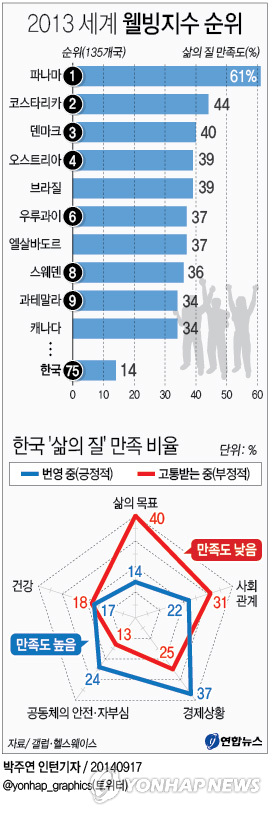
<그래픽> 2013 세계 웰빙지수 순위(서울=연합뉴스) 이재윤 기자 = 16일(현지시간) 미국 여론조사 기관 갤럽이 보건컨설팅업체 헬스웨이스와 공동으로 지난해 135개국의 2013 세계 웰빙(삶의 질) 지수 순위를 발표한 결과 우리 국민이 느끼는 삶의 질 만족도가 같은 아시아 국가 국민의 체감지수보다도 낮은 것으로 나타났다. yoon2@yna.co.kr @yonhap_graphics(트위터)
갤럽은 박근혜 대통령이 경제 성장과 국민 행복 시대 구현 정책으로 한국민의 삶의 질 개선에 노력을 기울일 것으로 전망했다.중앙아메리카의 파나마 국민은 3개 항목 이상 만족스럽다는 답변을 택해 긍정답변 비율 61%로 전체 1위에 올랐다. 파나마 국민은 삶의 목표(66%), 사회관계(68%), 공동체 안전·자부심(58%), 건강(63%) 등 경제 상황을 제외한 4개 항목에서 모두 만족 비율 1위를 달렸다.갤럽 조사관인 댄 위터스는 미국 일간지 USA 투데이와의 인터뷰에서 "과거 라틴 아메리카 국민을 대상으로 한 비슷한 조사에서도 파나마 국민은 특히 늘 웃고 낙천적인 삶을 즐기는 성향을 보였다"며 "개통 100주년인 올해를 겨냥해 2007년부터 개시한 파나마운하 확장 공사로 경제 상황이 나아진 것도 파나마 국민의 웰빙지수가 높은 원인"이라고 평했다. 파나마에 이어 코스타리카(44%), 덴마크(40%), 오스트리아·브라질(39%), 우루과이·엘살바도르(37%), 스웨덴(36%), 과테말라·캐나다(34%) 순으로 삶의 질 만족도가 높았다. 오랜 내전으로 민중의 삶이 피폐해진 시리아와 아프가니스탄 국민의 삶 만족 비율은 고작 1%로 최하위에 그쳤다. 그러나 끊임없는 흉악범죄와 가난 탓에 수많은 미국 밀입국자를 양산한 엘살바도르, 과테말라가 상위권에 자리하고, 비만 비율이 높은 사우디아라비아와 멕시코가 건강 지수 상위 10위에 오르는 등 현실과 맞지 않은 결과도 나와 신빙성에 의문도 제기되고 있다. 이에 대해 피터 추에리 헬스웨이스 인터내셔널 대표는 "정부, 고용주, 보험업자들이 현실과 여론 조사 결과 사이의 차이를 인지하면 보다 문화적으로 세심하게 거중 조정자로서의 노릇을 할 수 있을 것"이라고 주장했다.
cany9900@yna.co.kr
출처 http://www.yonhapnews.co.kr/international/2014/09/16/0601940000AKR20140916215700123.HTML
댓글 없음:
댓글 쓰기